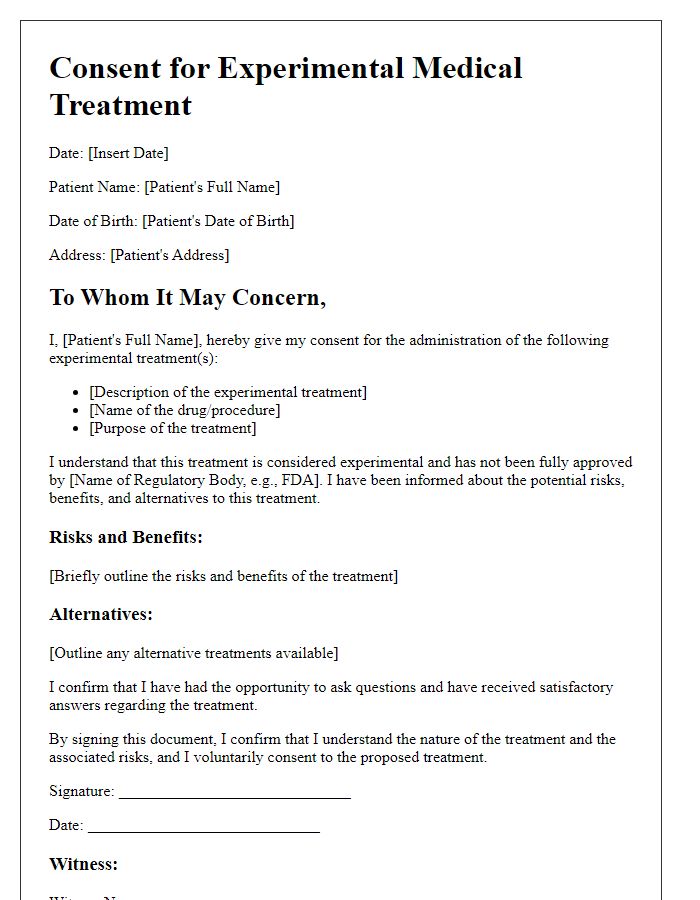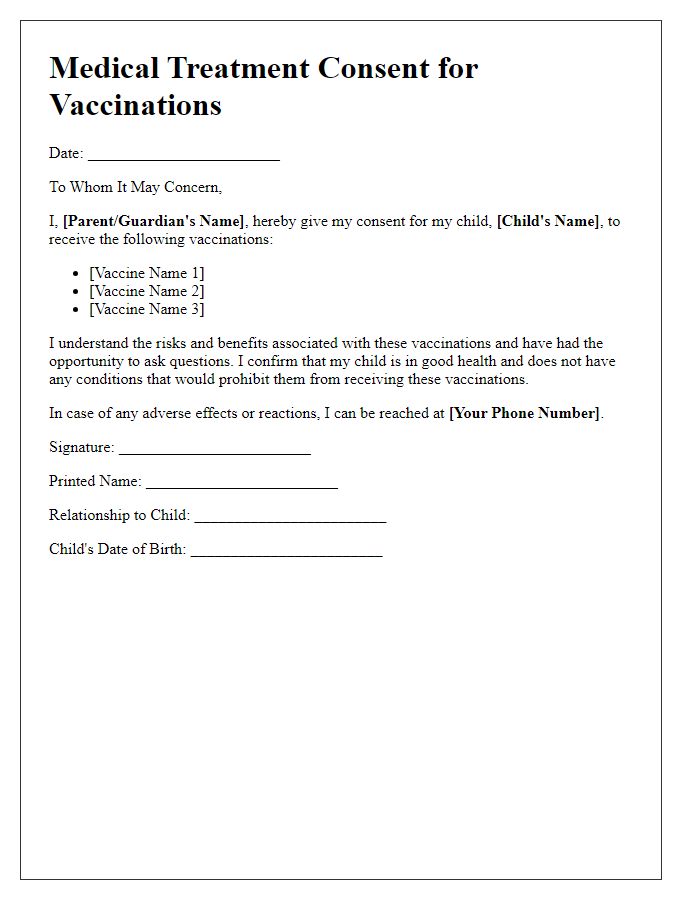When it comes to medical treatment, having a clear understanding of consent is crucial for both patients and healthcare providers. A well-structured consent form not only protects the rights of patients but also ensures that they are fully informed about the procedures they will undergo. From outlining potential risks to detailing the benefits, a thorough consent template is vital for fostering trust in the patient-provider relationship. Ready to learn how to create an effective medical treatment consent form? Let's dive in!

Patient Information and Identification
Patients providing consent for medical treatment must include important identification details. Full name (first, middle, last) ensures accurate patient records. Date of birth, typically in MM/DD/YYYY format, assists in verifying age and eligibility for specific treatments. Address, including street, city, state, and zip code, helps establish residency and contact information. Phone number (home and mobile) is essential for follow-up communication. Insurance details, including provider name and policy number, facilitate billing and coverage verification for the treatment process. Emergency contact information, indicating a name and relationship, ensures support availability during medical procedures.
Description of Treatment or Procedure
Medical treatment consent forms often include a detailed description of the specific treatment or procedure being proposed. For instance, a "knee arthroscopy" (a minimally invasive surgical procedure) may be described as a technique used to diagnose and treat various knee joint issues, such as meniscus tears or cartilage damage. This procedure involves making small incisions (typically 0.5 to 1.0 centimeters) around the knee, allowing the surgeon to insert a tiny camera (arthroscope) and surgical instruments. Anesthesia (either local or general) will be administered based on the patient's needs. The goal of knee arthroscopy is to relieve pain, improve mobility, and enhance the overall function of the knee joint. Potential risks, such as infection (occurring in about 1-2% of cases) or blood clots, will also be outlined to ensure the patient understands the importance of informed consent.
Risks and Benefits Discussion
When discussing medical treatment options, it is crucial to address potential risks associated with procedures such as surgical interventions, medication therapies, or diagnostic tests. Understanding these risks, including complications like infection (which may occur in 1-3% of surgical cases), allergic reactions to anesthesia (affecting around 1 in 10,000 patients), and post-operative pain, is essential for informed consent. Benefits must also be clearly articulated, highlighting improved health outcomes, enhanced quality of life, or potential life-saving capabilities, depending on the treatment. Patient education is vital, ensuring comprehension of how these factors interconnect within specific clinical settings, such as hospitals or outpatient clinics. Effective communication enables patients to make informed choices about their health care, reinforcing the importance of discussing personal medical history and exploring individual concerns or questions related to the proposed treatment.
Consent and Authorization Statement
Medical treatment consent forms are essential documents in healthcare, ensuring patients agree to procedures and acknowledge understanding of risks involved. Consent typically includes comprehensive information about the medical treatment being proposed, including any surgical procedures, diagnostic tests, or therapeutic interventions. Patients must be informed of potential side effects, complications, and alternative treatments available before signing. For example, if a patient is undergoing a surgery such as laparoscopic cholecystectomy (gallbladder removal), the form should clearly outline common risks like bleeding, infection, and anesthesia-related issues. Additionally, patients should have access to their medical records, allowing them to make well-informed decisions regarding their treatment. Understanding the importance of informed consent fosters trust between patients and healthcare providers, ultimately enhancing the quality of care.
Signature Section and Date
Informed consent for medical treatment holds significant importance within healthcare practices. The signature section establishes a formal acknowledgment from the patient (or guardian) regarding the understanding of the treatment plan. This section typically includes lines for the patient's name, signature, and date of consent retrieval. The date must reflect the exact moment when the patient agreed to the medical procedure, ensuring clarity in documentation and compliance with legal standards. Including the name of the healthcare provider and facility at the bottom enhances personalization and reinforces accountability. Properly completed forms serve as a protective measure for both the patient and the medical practitioners, safeguarding against misunderstandings and legal disputes.
Letter Template For Medical Treatment Consent Form Samples
Letter template of medical treatment consent for experimental treatments.

Letter template of medical treatment consent for mental health services.












Comments